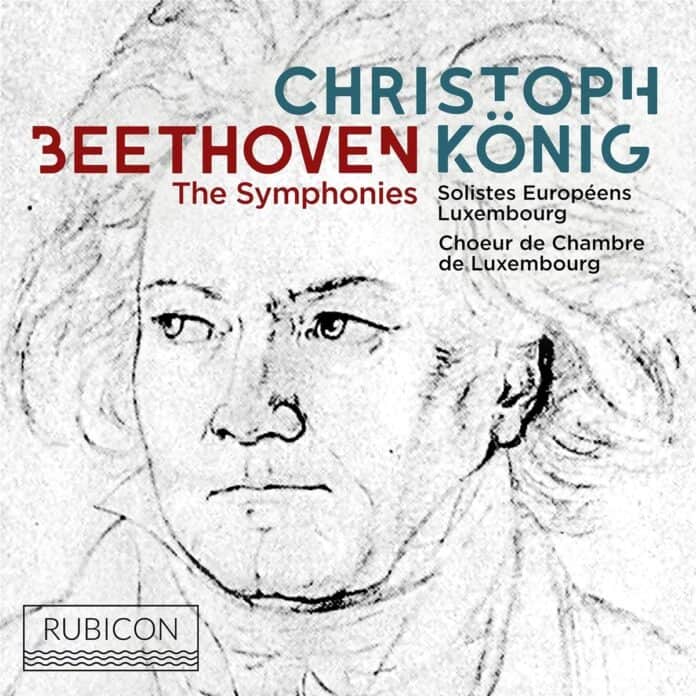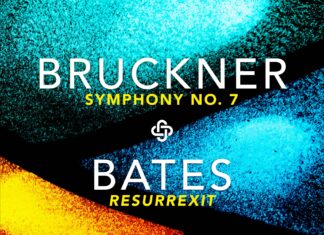Review – Beethoven Symphonies 1-9, The Creatures of Prometheus Overture & Nos. 9 & 16, Coriolan Overture, Leonore Overture no. 3 (op. 72b), Fidelio & Egmont Overtures, Symphony 10 First Movement realised and completed by Dr Barry Cooper / Christoph König (conductor) / Solistes Européens Luxembourg/ Genia Kühmeier/ Anke Vondung/ Michael König / Jochen Kupfer/ Choeur de Chambre de Luxembourg/ RUBICON
This is an impressive new set of the Beethoven symphonies, and the Solistes Européens Luxembourg prove a noteworthy and highly skilled team. Of course, on the helm is Christoph König, their chief conductor, who brings fresh air to these all too familiar works. Expect fleet tempi, clear, transparent textures, and precise playing. So this is going to be another HIP set, I hear you cry. It is indeed HIP influenced, but König avoids most shortcomings that characterise historical performance interpretation. First and foremost is the orchestra. The Solistes Européens Luxembourg might give the false impression of a small band of individual players (only because of their name) but their uniformity and fulness of sound are astounding.
When compared to other recent sets (such as the Janowski – reviewed here), König takes more interpretative liberties, and his approach sounds refreshing overall. Take the finale of the First Symphony, for example. König begins with a hesitating tempo, the strings meticulously sculpting the sound in this brilliant introduction before the playful accelerando, showcasing the brilliance of Beethoven’s genius. The beautiful Second Symphony has enough gravitas in the Allegro (I’ve always felt this movement in particular needs to make an impact) and the Larghetto that follows is impressively handled with expressive string playing and ideal pacing — not to mention the last two movements which are hugely satisfying.
König delivers a remarkable Eroica. The forward drive of the first movement is apparent, and the procession of the Funeral March is swift, the brass distinctive. In fact, the clarity of the playing and the lighter textures really help here, even though -and truth be told- the Eroica usually benefits from a weightier approach, richer strings, and more characterful winds. And this is also my only concern – I feel the winds, in particular, should be more present – occasionally they disappear or become inaudible in the second movement, but this is all a matter of balance since their contribution in the other symphonies is special. After all, the following two movements are greatly executed, the Finale, in specific, featuring some impressive string playing.
The 4th is a marvellous work which is often treated like a Haydn symphony. And while König and his forces have a fuller sound, there were moments where I felt more drama was needed overall (of course, if you want your 4th to belong mainly within the classical camp, you should be fine). I also wish the slow movement were weightier and gathered more tension. On the whole, though, it is a very fine performance.
Unfortunately, I found the 5th to be curiously imbalanced. While the Allegro finale is breathtaking in its execution, featuring some phenomenal string playing at these tempi, the first movement sounds tame. Everything is in place, but the rhythmic drive is missing, and the climaxes are not there.
The 6th, on the other hand, is a pleasure from start to finish with some expressive contributions from the Luxembourg players. The Scene am Bach is not only beautifully played but also touching, the strings and woodwinds offering some inspiring playing. Yes, there are more angry and ferocious storms on record but, again, the well-judged tempo of the finale makes up for it, despite the horns not being as prominent as in other recordings.
Unfortunately, the subdued horns are also a problem in the 7th -and if there is one Beethoven symphony where powerful brass is needed that is definitely the 7th! And even with a promising start, at 00:38 one gets to hear one of the most annoying coughs, wondering why this hasn’t been omitted from the recording. It is a curiosity, indeed. The Allegretto has all the underlying drama needed, but the brass is often covered by the orchestra in the tuttis which doesn’t allow the Scherzo and Allegro con brio finale soar as they should.
Perhaps the 8th is one of the most successful accounts in this set, along with the 2nd, 3rd and 6th. Sharp, precise tempi and a very Haydnesque approach – if you like your 8th this way, there’s plenty to admire in König’s performance!
The 9th is usually problematic in HIP recordings. But here orchestra and conductor offer an impressive account of this mammoth of works. There are many things to admire: the transparent string textures in the first movement, the precision in the second. True, I would still prefer a heftier approach, especially in the climaxes. The Adagio molto e cantabile at just 11:40 could have more Innigkeit (still, I don’t know if this a valid complaint since most performances nowadays fail to deliver a convincing account of Beethoven’s most sublime symphonic slow movement). As for the finale, there are some odd instrumental balances that the conductor favours (an odd emphasis to the winds) but overall this is a satisfying reading.
So where does this leave us? As far as recent sets are concerned, this is one of the best. I wish that some balances were more in favour of the brass and winds in certain passages, but speaking of the orchestra, they really play their hearts out in some symphonies, as in the beautifully characterised Pastoral. An excellent set then, the orchestral playing polished and urgent. König’s demonstrates that he is in control of these works, and his interpretative insights are more than welcome.
Reference recordings: Barenboim/Staatskapelle Berlin, Karajan/BPO (60s or 90s), Blomstedt/Staatskapelle Dresden, Wand/NDR
HIP set: Krivine/La Chambre Phlharmonique






